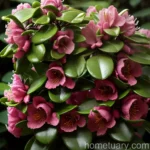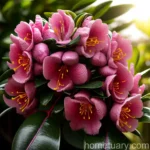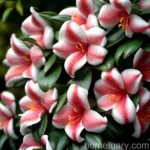Rosebay Rhododendron (Rhododendron maximum): A Comprehensive Guide to Care, Cultivation, and Landscaping
Introduction
Welcome to our comprehensive guide to rosebay rhododendron, or Rhododendron maximum, a stunning and versatile plant species native to the eastern United States. As a plant scientist and enthusiast, I’m excited to delve into the intricacies of this remarkable species, providing insights into its culture, uses, growth requirements, and maintenance. Throughout this guide, we’ll explore the various aspects of caring for and utilizing rosebay rhododendron in your home garden, landscape designs, and natural habitats.
What is Rosebay Rhododendron (Rhododendron maximum)?
Rosebay rhododendron, scientifically known as Rhododendron maximum, is a captivating evergreen shrub belonging to the Ericaceae family. With its lush foliage and showy clusters of flowers, this species is a popular choice for gardens, parks, and naturalistic landscapes. The rosebay rhododendron is indigenous to the Appalachians and thrives in diverse habitats, from stream banks and forest understories to mountain slopes and moist woodland areas. Its adaptability to various environments makes it a valuable addition to both cultivated and natural settings.
Key Takeaways – Rosebay Rhododendron (Rhododendron maximum)
Before we delve into the specific aspects of caring for and utilizing rosebay rhododendron, let’s summarize some key points about this remarkable plant:
- Name: Rosebay Rhododendron
- Scientific Name: Rhododendron maximum
- Family: Ericaceae
- Habitat: Eastern United States, particularly the Appalachian region
- Characteristics: Evergreen shrub with large, leathery leaves and impressive clusters of showy flowers
- Uses: Ornamental landscaping, naturalistic gardens, and habitat restoration
- Growing Conditions: Thrives in moist, acidic soils with partial shade
- Notable Traits: Cold-hardy, attractive to wildlife, and versatile in various landscape designs
Culture
Understanding the cultural requirements of rosebay rhododendron is essential for successfully growing and maintaining this species. From soil conditions to pruning techniques, each aspect of its culture significantly impacts its health and overall appearance.
Uses
The rosebay rhododendron boasts a wide range of uses, making it a valuable addition to both natural and cultivated landscapes. Whether planted in home gardens, public parks, or restoration projects, this species offers numerous benefits and aesthetic appeal. Some common uses of the rosebay rhododendron include:
- Ornamental Planting: Its attractive foliage and beautiful blooms make it an ideal choice for ornamental landscaping, adding color and interest to gardens and parks.
- Habitat Restoration: Due to its native range and ecological value, rosebay rhododendron is often used in habitat restoration projects, particularly in areas where it naturally occurs.
- Naturalistic Gardens: In woodland gardens and naturalistic landscapes, this species contributes to the overall biodiversity and visual appeal, blending seamlessly into the surrounding environment.
- Wildlife Attractant: The nectar-rich flowers of the rosebay rhododendron attract pollinators, such as bees and butterflies, enhancing the ecological value of the landscape.
Water
Adequate moisture is essential for the health and vigor of rosebay rhododendron. Although it can tolerate occasional dry periods, especially once established, this species thrives in consistently moist soil. When cultivating rosebay rhododendron, it’s crucial to ensure that the plant receives sufficient water, particularly during periods of drought or hot weather. Proper irrigation methods, such as deep watering, help maintain soil moisture and support the plant’s overall well-being.
Sunlight
The ideal sunlight conditions for rosebay rhododendron involve partial shade to full shade, making it well-suited for woodland environments and shaded garden areas. While it can tolerate some dappled sunlight, excessive exposure to direct sunlight, especially in hot climates, may result in leaf scorch and reduced blooming. Therefore, when selecting a planting site for rosebay rhododendron, it’s essential to prioritize locations with filtered light and protection from intense sun exposure.
Soil
Rosebay rhododendron thrives in acidic, well-draining soil with high organic content. The optimal pH range for this species typically falls between 4.5 and 6.0, emphasizing the need for acidic conditions to support its growth and nutrient uptake. Additionally, a rich and moisture-retentive soil texture, such as loam or peat-based mixtures, provides an ideal substrate for cultivating healthy and robust rosebay rhododendron plants.
Fertilizer
Proper fertilization plays a vital role in supporting the growth and flowering potential of rosebay rhododendron. While this species is relatively low-maintenance, periodic fertilization can enhance its overall health and performance. When applying fertilizer, it’s crucial to choose a formula specifically designed for acid-loving plants and to follow the recommended application rates to prevent over-fertilization. A balanced, slow-release fertilizer tailored to the needs of rhododendrons and other Ericaceae species can provide essential nutrients without causing the potential for nutrient imbalances or adverse effects on the plant’s root system.
Pruning
Pruning rosebay rhododendron is an important aspect of its maintenance, contributing to its overall shape, density, and flowering potential. When applying pruning techniques to this species, it’s essential to consider its growth habits and bloom cycle to achieve optimal results.
Propagation
The propagation of rosebay rhododendron can be achieved through various methods, including seed germination, cuttings, and layering. Each propagation technique offers unique advantages and challenges, allowing growers to select the most suitable approach based on their specific requirements and resources.
Container Popularity
While rosebay rhododendron is predominantly known for its presence in natural and cultivated landscapes, it also holds significant appeal as a container plant. Cultivating this species in containers allows for greater flexibility in terms of placement and mobility, making it an attractive option for patio gardens, urban landscapes, and small-scale environments.
Container Common Diseases
When grown in containers, rosebay rhododendron may be susceptible to certain common diseases and issues that can affect its overall health and vitality. Understanding these potential challenges and implementing preventive measures are essential for successful container cultivation of this species.
Disease Diagnosis
Diagnosing and addressing diseases affecting rosebay rhododendron in containers requires a thorough understanding of the symptoms, causal agents, and management strategies associated with these conditions. By recognizing the signs of common diseases, growers can take proactive measures to protect their plants from potential threats and maintain their overall well-being.
Common Pests
Pest infestations can pose significant challenges when cultivating rosebay rhododendron in containers. Identifying common pests, understanding their behaviors, and implementing effective control measures are essential for preventing damage and preserving the plant’s vigor.
Botanist’s Tips
As a plant scientist and enthusiast, I’ve curated a collection of practical tips and recommendations for successfully caring for and utilizing rosebay rhododendron in various settings. These insights draw upon both scientific knowledge and practical experience, offering valuable guidance for plant enthusiasts and landscapers alike.
Fun Facts
Uncovering the fascinating aspects of rosebay rhododendron provides a deeper appreciation for this species and its ecological significance. From unique botanical features to ecological interactions, exploring the fun facts surrounding this plant sheds light on its diverse attributes and contributions to the natural world.
Links to External Resources
To further expand your knowledge of rosebay rhododendron and enhance your understanding of its care, cultivation, and landscaping applications, I’ve compiled a list of reputable external resources. By exploring these links, you can access additional information, research findings, and practical insights from experts in the field.
As we continue our exploration of rosebay rhododendron, let’s delve into specific aspects of its care, cultivation, and landscaping, drawing upon the wealth of knowledge and experience associated with this remarkable species.
References
- American Rhododendron Society. (2021). Rosebay Rhododendron (Rhododendron maximum). https://www.rhododendron.org/descriptionH_new.asp?ID=425
- Dirr, M. A. (2009). Manual of Woody Landscape Plants: Their Identification, Ornamental Characteristics, Culture, Propagation, and Uses. Timber Press.















